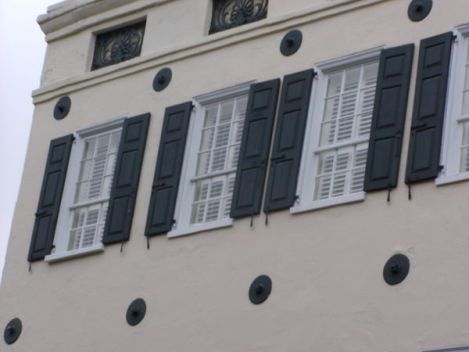
I’ve always been drawn to history. Stories of old that reveal truths from the past. Stories of families, love and even tragedies. I’m not sure why it intrigues me so. Maybe it opens my eyes to the fact that, while both good and bad fall on the just and the unjust, our world continues on. Many times I’m encouraged by people who’ve suffered much yet, inspired by hope, have overcome adversity.
Each time I visit Charleston, South Carolina, I try to learn more of its history. Whether it be through an educated tour guide driving a horse-drawn carriage or roaming around some of the centuries-old homes whose facades tell stories of a society filled with graceful charms and painful struggles, each new detail fascinates me.

Evidence of battles with man and nature are etched upon many of the buildings scattered throughout the old city. From the great fire of 1861 that resulted in more damage to that city than the civil war, to, more recently in 1989, hurricane Hugo, the most destructive hurricane ever recorded at the time. McClellanville, a town only 39 miles from Charleston, took the direct hit of Hugo’s fury, leaving nearly 100,000 residents homeless.
But the most destructive blow came on August 31st, 1886, when the largest earthquake ever recorded in the history of the southeastern United States shook the city so violently some said the streets looked like waves ascending to at least ten feet. The approximated 7.6 magnitude quake lasted about one minute and was felt over 2.5 million square miles; as far north as Boston, Massachusetts, as far west as New Orleans, Louisiana, as far south as Cuba and as far east as Bermuda. It’s said that two-thirds of all Americans felt the tremors. The fallout was devastating, leaving no structure in Charleston untouched.


Despite the seemingly hopeless aftermath, Charlestonians were back to work within a week and repaired the city in fourteen months. Ironically, due to the lack of funds available for a complete rebuild, many of the structures had to be refurbished rather than demolished, thus eventually becoming Charleston’s saving grace as it is one of the most historical cities in America.
In order to rehabilitate many of the dilapidated structures, however, earthquake bolts were needed to provide added stability. These steel rods ran through the entire length or width of the building, literally screwing bolts into the walls at each end. Every so often the owner would tighten the turnbuckle that would slightly compress the outside walls until, over a period of years, the house became as upright as was possible.
Unfortunately, homeowners weren’t thrilled with these ugly bolts screwed into their beautiful homes and started putting decorative plates behind the bolts—such as stars, lion heads or crosses—thus creating an enhancement to the property. Since that time, newly constructed buildings have purposely been adorned with purely decorative bolts and plates, adding a look of authenticity.


Like these old homes that struggled to remain upright after natural disasters, sometimes I’ve felt off kilter and hopeless, wondering how I’d ever make sense of things again.
When God allows me to go through storms, whether in relationships, circumstances or the pressure of life in general, it feels as if God’s threaded an earthquake bolt through my soul and rotated the turnbuckle. The pain is real and uncompromising, but, if I trust Him, I discover He’ll put me back together in a way that makes my scars beautiful—just like those decorative plates.
A while ago, I endured a year of deep depression. I didn’t understand that God was using the pain and hopelessness of that horrible season to make me stronger. But now I see God’s purpose in it and look back at that time with a grateful heart. I’m thankful I chose to lean into God for support. In return I received assurance of His presence and love. The scars I have today tell my story and reveal the authenticity of my faith.

If you’re going through a season of hopelessness, know that God has great plans for you. We are born sinful and God loves us enough to shape us into a more Christ-like image. It’s never easy and mostly painful, but if we’ll trust Him with each day, He’ll be faithful through the storm. He promises to never leave or forsake His children. And His mercies are new every morning.

1. Are you struggling through a storm in your life right now? Reading through the Psalms is a way to encourage and renew your faith in God. Psalm 40 was especially comforting to me
2. Have you experienced God’s faithfulness during a difficult season? Take time to reflect on ways God revealed Himself to you during that time and thank Him for being there.
3. Do you know someone who is facing a terrible situation right now? Think of ways you can make a difference by showing God’s love to them during trying times.
Let’s work together to build kingdom homes!

I love Charleston and the homes, churches and other buildings. I’d heard about the bolts running through the buildings. Often, they are topped with a star. Goes to show the creativity and workmanship the people of the city have.
Thanks for the post and the application.
Those Charlestonians were pretty creative people, huh, Tim? Thanks so much for stopping by and commenting!
So, so good, Carol. I too love history and I learned a lot from your blog post. But most of all I was reminded that our scars can be a testimony to God’s grace and faithfulness.
I’m glad there are others that enjoy history as much as I do, Cathy. It’s amazing what we can learn from the past. Thanks for your encouragement!
Great application, Carol. What an encouragement when we go through the hard times.
Thanks Ellen! I’m glad you appreciate the application. Maybe next time I’m going through a difficult season I’ll think about those earthquake bolts! Thanks for commenting 🙂